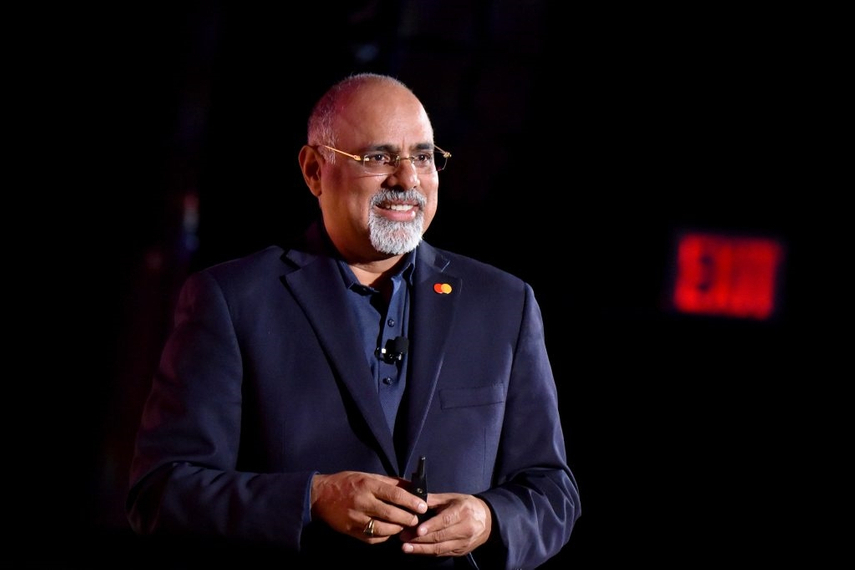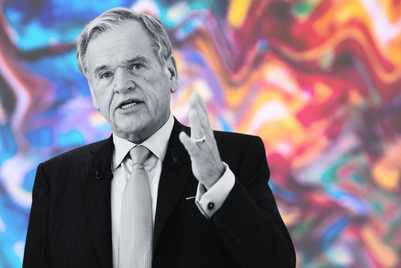
Close your eyes and imagine what a brand tastes like. No, not McDonald’s or KFC or Pizza Hut, but a financial services brand. Or stare at its wordless logo and guess the name. Try thinking beyond the big leagues of Nike, Starbucks or Apple. A brand so ubiquitous and so deeply intertwined in popular culture, that consumers recognise it by hearing the six-note tune after every transaction.
That’s Mastercard for you, and its ambition to de-emphasise from the traditional and pivot from the polluted digital environment. To ostensibly align with a sleeker and more streamlined approach to modern economy. To see all elements of its business as “priceless” and dabble in multiple industries and multiple touchpoints all at once. To “decorporatise”. To build the brand around experience. To cut through consumer fatigue and the constant reminders to purchase. That’s the paradigm and the ground rules global CMO Raja Rajamannar has set for the payments brand.
During a recent visit to Hong Kong to inaugurate the region’s first Mastercard restaurant, Campaign sat down with the marketing veteran to understand the tactics that Mastercard has learned and subtlety unlearnt to stay relevant through the years.

“Today, marketing is at a major inflection point, traditional marketing as we know it is dead. It’s harder to reach consumers only through advertising campaigns. Many marketers have lost their seat at the table and they are struggling to justify their investments to the CEOs and CFOs. There’s a somewhat existential threat,” says Rajamannar.
The gloom and doom isn’t tremendously exaggerated.
The advertising ecosystem has tremendously changed over the years, but people still hate ads. Hootsuite’s 2022 Digital Trends Report states that roughly 43% of internet users worldwide deploy ad blockers. Ad block (a popular blocking extension) alone has more than 65 million users.
When the default is sameness, it’s easy for customers to get jaded. For brands, it’s becoming increasingly harder to reach and entice audiences. And in this cluttered environment, Mastercard’s experiential marketing bet seems to be paying off. Recently, Kantar’s BrandZ Ranking report gave them a number nine spot in the list of the world’s top 100 brands.
“With experiences, you don’t sell a product; you sell a moment. And this shift has made a huge difference to our brand perception and the feelings about our brand in people’s minds and heart. Advertising is about telling a story; experiences are about making a story,” adds Rajamannar.
And that’s the thing with “priceless”: more than a product, it sells a lifestyle. A lifestle so expansive and ambitious and inclusive, it can go anywhere the brand wishes it to go. In this case, Mastercard’s foray into luxury dining in Hong Kong. But why F&B and why this battered city trying to reclaim its image post-Covid and amid raging US-China tensions?
“Why not F&B and why not Hong Kong?” chuckles Rajamannar.
“People are passionate about fine dining and food here. It’s Asia’s food capital for a reason. And as marketers catering to the needs of almost 2.2 billion consumers around the world who have a Mastercard means, we have to be creative. We have to be lateral in our thinking. And that’s how ‘Priceless Tables’ was born when we started putting tables in the most unexpected places in the world. Like the top of a billboard in Times Square [Manhattan] and we served a five-course meal by a Michelin-starred chef. Then, at the next level, we didn’t want to be restricted to tables alone but to create our own restaurants. We started in Rome, New York, Brazil, Mexico, and are absolutely delighted to have Asia-Pacific’s first one in Hong Kong,” elaborates Rajamannar.

Multi-sensory symphony of success
The strategy fits well into the credit card company’s wider plan to centre all efforts in the multi-sensory space. In addition to touch (touch card), sight (the standard visual ads, logos etc.), Mastercard has dipped its toes in taste (F&B), the brand shows up in sound (sonic branding) and now smell (scents: Passion and Optimism)—as part of its iconic ‘Priceless’ campaign.
“There is science about how sight, sounds and smell can all evoke powerful emotions. There is a reason why we universally like a voice as powerful as Morgan Freeman’s and why we like certain melodies and not the others. In fact, even within a melody, each note, amplitude, your modulation – everything has an impact on how you feel about something. In fact, we took two years of research to come up with our sonic logo” he adds.
Mastercard’s peppy six-note ditty that plays after every successful credit card transaction and has been making its way to point-of-sale terminals around the world, was game-changing at its 2019 launch. With voice-shopping crossing the US$40 billion mark in 2022, a sophisticated audio interaction seems like a must-have for brands.
“My first exposure to the science of sound was at a Bose showroom where they put a horror film and then completely turned the volume down and the fear factor was almost zero. It was flat, like nothing at all. But when they started increasing the volume again, the fear factor, the anxiety and the heartbeat, everything kept going up. And then suddenly, it drops. Music can pack emotional weight that a flat logo cannot. Music and sound create a memory that stays with us,” he quips in.
In an increasingly auditory world with podcasts and voice assistants, the commercial value of sonic branding is undeniable. And the trend is visible in the growth explosion and acceleration of brands getting themselves a sonic identity. Netflix’s “Tu-dum” or McDonald’s “Bada Ba Ba Ba” or the ding sound of a Macbook when you start it, are called sonic logos.
But practically speaking, the noisy chaos of the real world combined with the technical hurdles of retail—with many shopkeepers still on the old payment machines that only beep after a transaction instead of chirping, and with no financial incentive to update—sonic logos can often be mute to the consumer’s ear. Also, cash registers at noisy checkouts aren’t exactly the kind of places where a Ta-run-tun-ta-run-tun would be heard. All three big payment companies Visa, Mastercard and American Express, have a distinct and unique audio cue. So, is sonic branding increasingly just a nice to have or does it still carry weight?
Rajamannar makes a passionate case for its effectiveness.
A single bespoke sonic item is not enough to develop brand equity, he says. In an audio-first world, brands have to go beyond a hook or a jingle to understand that sonic identities work best when sprinkled in the entire marketing ecosystem.
Case in point is TikTok’s sonic identity launched in late 2022, which has already surpassed industry benchmarks, according to Kantar’s June 2023 research.
TikTok Sonic Logo from MassiveMusic on Vimeo.
Kantar and MassiveMusic, the company that created TikTok’s sonic identity, conducted a sonic brand tracking report to find that TikTok’s sonic logo has struck a chord on parameters like emotional affinity and connectivity, the brand recognisability rate shot up to 52% and it came on top of the most recognisable sonic logos of the year list, garnering 70% recognition out of over 130 sonic logos from all major brands across US.
Coming back to Mastercard, the payment brand has used sound as a holistic marketing strategy via a pop song, a TikTok campaign, and a full-length album with Beatclub, the music creator platform founded by super-producer Timbaland. 2022, it says, was a big year to make a distinct and memorable connection with consumers. And with an emotionally appealing tagline like ‘Priceless,’ Mastercard can show up wherever sound can.
The album features artists from the United Kingdom, Lebanon, Sweden, Colombia, Algeria, India, Australia, Slovenia and the U.S., potentially giving it a wider reach whilst rooted in diversity and culture.
Rajamannar tells Campaign that within a year of Mastercard’s sonic brand identity, the company (through its own proprietary tools) found that 77% of its customers believed its brand identity was more trustworthy. When the sound played after a completed transaction, customers felt they were transacting with a trusted merchant.
Forging trust is a key KPI for a financial firm’s branding and marketing; that sonic logos are able to achieve, is a huge victory.
“We became the world’s number one audio brand on criteria such as trust, recognition, engagement and efficiency, this was backed by science. Brands fail in sonic branding when they just come up with a catchy jingle. That's not sonic. You need to have a proper architecture. We have 10 layers in our architecture, and we have just unleashed just four of them. We will release the next six over the next three to four years. And that is differentiating force,” he explains.
Quantum leap
On the business side, Rajamannar talks at length about the ROI mechanisms that determine the success of such experiential pivots. That’s a non-debatable issue for him but the challenges of creating pocket-friendly experiences at scale for a company that operates in over 210 markets worldwide persist.
During Covid, campaigns like ‘Priceless at home’ helped to deliver digital experiences at scale. But unlike the West, extended lockdowns in most parts of Asia, especially Greater China, meant rising digital event fatigue. In fact, LXA’s B2B State of B2B Digital Event Experience 2023 found that a whopping 81% of US CMOs believed that their customers are reeling through digital fatigue. Though digital has now morphed into hybrid in 2023, is this still a cause of worry for a company that bets so heavily on experiential marketing?
“Not at all and I disagree that there is an experiential fatigue. Yes, it can happen if a brand delivers the same experience as everyone else or repeatedly offers the same event. You have to remember to be unique and give consumers bragging rights with events. Remember that novel is memorable,” he advises.
That said, enthusiastic caution must be baked into every marketing ploy because whilst novel is memorable, it can also border on gimmicky and invite negative backlash or total boycott. “If the agenda is only to seek visibility and it’s done without content backing up, the brand can fall flat. But if your commitment is towards authentic fulfillment and execution is flawless, it will blow away your consumers. In the restaurant line, if we start cutting corners on the show factor, the quality of the ingredients, strip off the delight of good service and ambiance, we won’t make a mark,” he adds.
Rajamannar also serves as the president of the World Federation of Advertisers (WFA); he comes down heavily on marketers that still rely on obsolete marketing methodologies.
“Marketers have to invest heavily with time, effort and learning; otherwise, they will be history. There will be an unprecedented level of disruption in the coming years. Like I said, it’s a moment of inflection; new tech has leveled the playing field. It’s a golden opportunity for small companies to compete with the deep pockets of big brands,” he adds.
Metaverse masterstrokes
Most brands sounded the death knell of the metaverse. Meta lost US$ 13.7 billion on Reality Labs in 2022 as Zuckerberg's metaverse dream fell flat, leaving journalists to wonder if it was all a fad or really a paradigm shift. Rajamannar opines, the technology is too new to emerge in its full form, just yet.
“The concept is promising, but yes, it’s all relatively nascent, the technology hasn’t evolved enough to deliver to its full potential,” he says.
“The social and the immersive element, the augmented reality experience is terrific, the constraints of the physical world are gone. But it’s still not the platform for scale. Decentraland hardly has 300,000 people on it. For a luxury event with a reach of 2,000 people, it’s a viable option. But for mass appeal, it’s still not the platform; at best, it’s a test market.”
Mastercard is not a web3 company, in fact as a payments giant, it could be the antithesis of the decentralised version that advocates are trying to build, but its global CMO remains bullish on the concept. The challenges and the technical issues with the metaverse, he says, will be fixed in three to five years from now. So, is the metaverse door shut till then, we ask.
“Not at all. We are keeping a close eye. It’s amateurish to walk away or go all in,” he says.
Currently, Mastercard allocates a small budget for innovation in projects on the metaverse. The opportunities with generative AI is something he says the brand cannot afford to ignore.
“It’s exciting. AI has been the core of our innovation for the better part of the last decade. Generative AI offers profound possibilities for creativity. It cannot be an original creative but it does add speed and efficiency. But we will approach it in a principled way. The risks right now are too many to ignore,” Rajamannar said.
So, is Mastercard leaning in on the AI hype train?
“We are playing with it internally, but till the regulation around AI is clearer, our in-house rules state– it cannot be deployed in production. Our agencies have to take explicit permission to use it,” he adds.
Whilst the legal hurdles around the use of generative AI and brand safety are untangled, a good starting point for marketers, Rajamannar advises will be to use this time wisely to educate.
“If you look at history, at every paradigm shift in marketing there were two technologies at a time. Right now there are more than two dozen; 24 to be accurate. Unless marketers educate themselves, educate their teams, seize the agenda and take that quantum leap, they will be history.”
Just like Ryan Reynolds said in the Mint Mobile ad created by ChatGPT, all this feels “mildly terrifying, but compelling.”
(This article first appeared on Campaign Asia)


.jpg&h=334&w=500&q=100&v=20250320&c=1)
.jpg&h=334&w=500&q=100&v=20250320&c=1)


.jpg&h=334&w=500&q=100&v=20250320&c=1)

.jpg&h=334&w=500&q=100&v=20250320&c=1)


.jpg&h=334&w=500&q=100&v=20250320&c=1)

.jpg&h=268&w=401&q=100&v=20250320&c=1)


.jpg&h=268&w=401&q=100&v=20250320&c=1)
.jpg&h=268&w=401&q=100&v=20250320&c=1)


